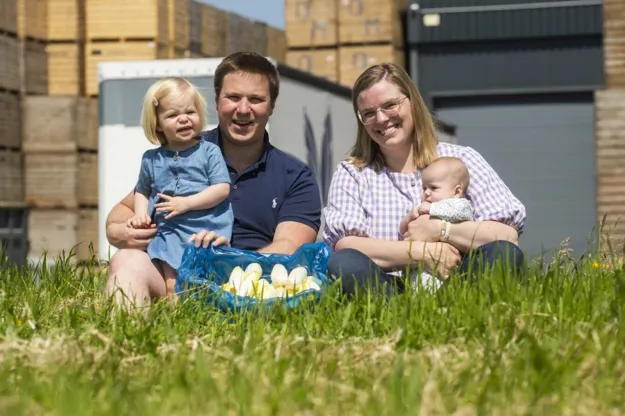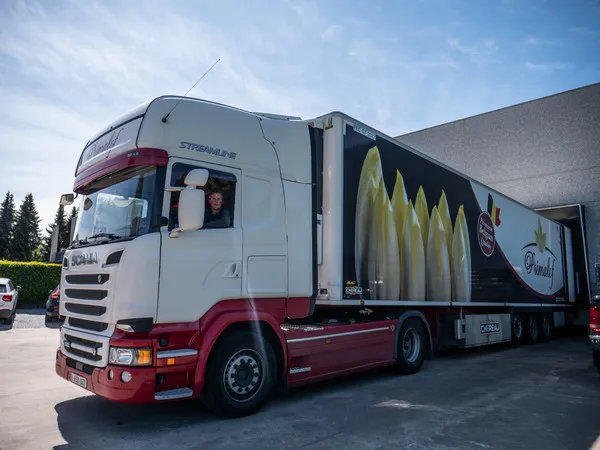Most of Belgium's chicory crops have been harvested. At Primalof, Charles Cattoir reflects on an average yield. "That's remarkable enough in these times. Perspectives are changing. After experiencing years with yields 30 to 40 percent below normal, achieving an average yield feels like a relief," says the grower and trader from Oosterzele, Flanders.
"The harvest went fairly smoothly this year," Charles continues. "The first two weeks of November brought excellent conditions, allowing us to harvest everything we needed quickly. Overall, we harvested a bit earlier, noticing that the early chicory roots were somewhat disappointing in terms of yield. Volumes were more limited, and the roots were generally thinner. Now that everything is in, the yield appears average, and the quality of the later pens is also satisfactory."

"It's still challenging because we're facing a significant shortage of carrots from the 2023 harvest," he explains. "That has been hard to miss. Pricing in Belgium, the Netherlands, and France has been exceptionally high this year, reaching extreme levels in 2024."
Consumers must not be alienated
Charles is uncertain if prices will peak again in the weeks leading up to the holidays. "I don't have a crystal ball, but last year's prices were very high—too high, in many cases. That hurt the market. While it might have been beneficial in the short term for some, no one had a full supply, so no one fully capitalized on it. The key is not to drive consumers away. If prices are too high, you lose them. Yes, market forces dictate higher prices during shortages, but more players in the market are striving for stable pricing that benefits everyone. We need to ensure chicory remains accessible and doesn't become a niche product."
"In that sense, this year is helpful. Demand has remained consistent throughout the year. We didn't experience a very hot summer, and now that production volumes are under control, we can work with stable pricing. Additionally, the sector always has promotional strategies planned. As a supplier, it's great to participate in those promotions. Early in 2024, we couldn't, but in 2025 we will. This is healthy for the market, as keeping a product in the spotlight is crucial. Chicory should have the same promotional focus as cucumbers and tomatoes, not just rely on its quality alone."
Quest for new varieties and resources
Despite the positive developments, Charles points to ongoing challenges. "It's been a better year, but the issues for 2025, 2026, and beyond remain the same—whether yields are good or bad. The resources we've relied on are running out. What's next? About 75% of the chicory acreage in Belgium and the Netherlands is based on ALS varieties, which can't be used with the new crop protection products being approved. People are urgently searching for alternatives, but they're not available yet."

"We've conducted several tests with different seed companies over the past few years. These are showing progress and will eventually allow us to transition to the new varieties, but the seeds are not yet commercially available and haven't proven themselves like the traditional varieties. Productivity is also much lower, so significant challenges remain."
"As an industry, we tried to secure an extension for the use of existing crop protection products, but we failed," Charles continues. "This outcome was expected, but it means we're now entering a period of uncertainty about the future. Tests and developments are underway, but there's no definitive solution to secure the current acreage. There likely won't be one by 2025 and probably not until 2026. This requires businesses to adapt, something we've been working on for about four years."
"These challenges are compounded by rising costs. For example, in the five years I've been in this business, the cost of a chicory root has nearly doubled. On the bright side, there's growing recognition of the value of healthy food, particularly fruits and vegetables. Since the COVID-19 pandemic, vegetables have been commanding fairer prices. In a year like 2024, someone always loses out—that's often the nature of the traditional model—but we're seeing increased collaboration within the supply chain. Everyone must be able to earn a fair return from chicory, and awareness of this is growing. Whether through fair pricing or knowledge sharing, this is a positive development for the sustainability of the chicory sector and the vegetable industry as a whole," Charles concludes.
For more information:
Charles Cattoir
Primalof
Leeg Bracht 23
9860 Balegem, Belgium
Tel: +32 (0)483 48 47 17
[email protected]
www.primalof.be
